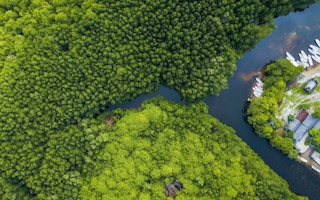For millennia, natural infrastructure – such as river systems, wetlands, coastal plains, sand dunes, and forests – supported the development of human civilisation. In fact, our ability to harness such infrastructure, for everything from food and drinking water to storm-surge protection and flood mitigation, has been central to our success as a species. And it will prove vital to our future survival.
Technological advances propelled the evolution of infrastructure. Green turned to grey, with concrete, cable, and steel delivering energy, communications, and transportation – and, with them, unprecedented growth and development. But while rapid modernisation produced once-unimaginable prosperity, it has had grave unintended consequences, not least the environmental degradation and greenhouse-gas emissions that are jeopardising our very existence.
The question now is how to meet urgent environmental goals – reducing emissions and protecting and restoring nature and biodiversity – while enabling developing economies to fulfill their legitimate growth aspirations. The answer, as a recent report from the Asian Infrastructure Investment Bank suggests, may well begin with an explicit acknowledgement of nature as infrastructure.
Viewing nature as infrastructure is transformative, because it forces us to think in a more systemic way. As we pursue growth and development, we must not only avoid damaging nature; we must also strengthen and enrich it through “nature-positive” investments – all while tapping its vast potential to deliver essential services.
Biologists already do this when they benchmark how to restore degraded land. But now economists must get on board and enhance their tools for capturing the value and complexity of natural capital. Biodiversity, for example, covers not just the number of species, but also their genetic diversity and diversity of functions. Yet another dimension of biodiversity is the complex evolutionary history of species – when they were separated on the “tree of life.” It is only by deepening our understanding of biodiversity that we will comprehend nature’s full potential – and our impact on it.
This knowledge is very site-specific, and acquiring it will require contributions from scientists and local populations. The good news is that there are already models for such collaboration. The massive Sanbei reforestation project, aimed at preventing two large deserts from merging in Northern China, was a flawed endeavour at the start, with only single tree types planted. But, over the course of two decades, deeper knowledge of the local environment and the participation of local communities transformed it into a success.
Governance and incentives are also crucial to protect and nurture natural infrastructure. In Indonesia, mangroves have long protected communities, particularly poorer households, from deadly tidal floods, but they are being depleted in regions with weaker state capacity. In Egypt, by contrast, efforts to restore mangroves have been aided by revenues from eco-tourism and beekeeping, which produces honey and supports the delivery of vital pollination services.
The nature-as-infrastructure approach demands that we assess what nature can deliver before considering grey solutions, and it can help countries close their infrastructure gaps in truly sustainable ways. But grey infrastructure will always be necessary for growth and development. This demands that we design it better, to minimise its impact on nature. For example, renewable-energy infrastructure has a large ecological footprint, and road infrastructure fragments and damages ecosystems. Solutions like co-locating infrastructure on brown sites and providing auxiliary infrastructure (such as wildlife highway crossings, green urban spaces, and nature-restoration offsets) can help mitigate these effects.
Of course, financing might pose a challenge. The Kunming-Montreal Global Biodiversity Framework, agreed a year ago, assumes that $598-824 billion per year will be needed by 2030 to close the biodiversity funding gap. Such sums, needed to protect and then begin to restore nature, can be generated only by valuing nature properly and creating markets that will mobilise private and institutional capital.
To this end, “nature as infrastructure” must be developed as an asset class, using new tools and financial instruments. At the micro level, this will require better pricing of nature’s services – for example, usage charges or permits and taxes for damaging activities – and adaptive local regulations. Micro-level policies can support the development of other financial instruments and, eventually, markets – for performance-linked bonds, policy-based lending, debt-for-nature swaps, and nature credits, to name a few – to channel more finance into nature. Lessons from carbon markets should be heeded, to avoid repeating past mistakes.
Special attention must be paid to low-income economies, many of which are highly vulnerable to climate change and environmental degradation but have rich natural endowments that should be valued properly. Multilateral development banks can catalyse the nature-as-infrastructure approach, ensuring that it is incorporated into all aspects of their operations. Ultimately, this approach should also guide individual infrastructure projects and national growth strategies.
The consequences of the infrastructure decisions we make today will be felt for decades to come. Only by committing to invest in green – and to build grey better – can we ensure we lay the groundwork for a fairer, more sustainable, and inclusive global economy.
Erik Berglöf is chief economist at the Asian Infrastructure Investment Bank.
Copyright: Project Syndicate, 2023.
www.project-syndicate.org


















